Sweet, spicy and moderately spicy purple onions and their varieties
Purple (the correct name is red) onion occupies a special place among the onion variety, distinguished by its unusual attractive color, mild taste and aroma. How is lilac onion useful, what are its advantages and disadvantages, features of cultivation and care? We will talk about this in detail.
Description
Purple onion is a perennial herbaceous plant.. All its parts, except the roots and husk, are edible. It has no external differences from other plants of the genus, with the exception of the unusual coloring of the underground part - the bulb.
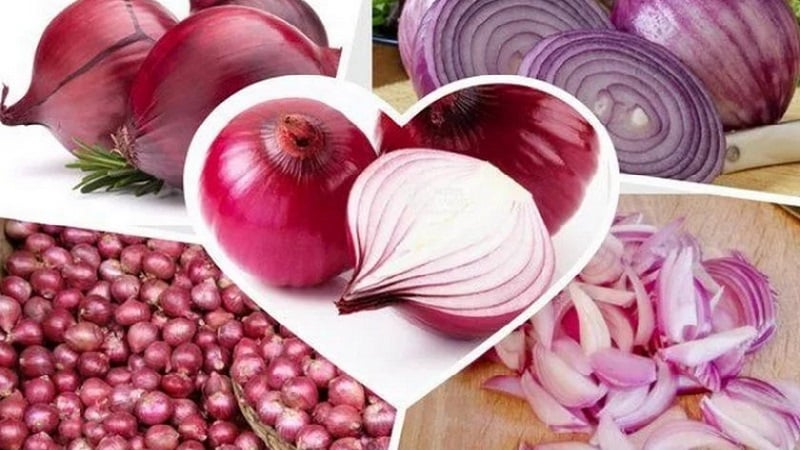
These onions are used mainly fresh. – in salads, side dishes, and also as an independent snack. And here during heat treatment it loses color and taste and gives the dish an unsightly bluish tint.
Characteristics of the bulb, appearance, taste
The purple bulb has a medium (50-100 g) or large (more than 100 g) size and consists of white-lilac juicy scales with a pleasant crunchy structure. Single-layer membranes between the scales are colored red-violet. The color of the husk can be red, burgundy, purple, blue and almost black.
The taste of salad onions depends on the variety, with sweet, semi-sharp and spicy varieties distinguished. However, even in hot varieties, the onion pulp has a milder taste and aroma compared to the yellow onion.
Origin and development
According to one version, sharply spicy purple onions were brought to Russia in the 19th century from Spain. or Portugal, from the island of Madeira.And only many years of work by Russian breeders made it possible to rid the vegetable of bitterness and give it a pleasant sweetness.
According to another version, the birthplace of red onions is Central Asia, and work to improve its taste was carried out in Crimea.
Benefits and harms
Purple onions are a salad variety that have a pleasant taste and mild aroma. The greatest concentration of essential vitamins and minerals is concentrated in the very top layers of the onion.
Salad onions contain many antioxidants, which promote rejuvenation of the body and restoration of tissue cells, as well as anthocyanin, which resists inflammation and strengthens the immune system.

The vitamin compound flavonoid quercetin imparts to purple onions antitumor and antiallergic properties, and the cysteine it contains removes toxins, inhibits the formation of cholesterol plaques, and normalizes blood sugar levels.
The vegetable is widely used in cosmetology for rejuvenating and regenerating masks, as a remedy for hair loss.
Red onion promotes weight loss due to the removal of toxins, accelerating metabolism, breaking down fats, normalizing digestion, and relieving swelling.
Among the contraindications for use – gastrointestinal diseases (gastritis, pancreatitis, colitis), hypertension and asthma.
Chemical composition
The vegetable pulp contains:
- vitamins C, E, P, group B;
- glucose, sucrose, maltose, fructose, nitrogenous substances, carotene, nicotinic acid, essential oils;
- minerals: potassium, magnesium, zinc, bromine, chromium, iodine, calcium, iron, selenium.
The nutritional value: 42 kcal per 100 g of product.
Contents of the BZHU:
- proteins – 1.4 g;
- fats – 0 g;
- carbohydrates – 9.1 g.
Sugar content:
- in spicy onions – 9%;
- in the peninsula – 7-8%;
- in sweets – 6%.
Ripening period
The ripening period of purple onions depends on the variety and climatic conditions and amounts to:
- for early ripening varieties – 90-100 days;
- for mid-season - 100-120 days;
- for late-ripening ones - more than 120 days.
Almost all spicy varieties of purple onions are early ripening. Sweet and semi-sharp varieties are mid- and late-ripening.

Productivity
Red onion is characterized by high yield: 100 seeds (about 0.4 g) after ripening yield more than 11 kg of onions.
The best varieties reach 7.5 kg per 1 m² of area (Red Bombay variety), the average yield is 1.5-3.5 kg per 1 m² of beds.
Spicy onion varieties are less productive, and the highest yield is produced by sweet varieties.
Disease resistance
Purple varieties are resistant to characteristic onion diseases and pests.
Moreover, most varieties acquire such resistance during primary seed treatment and appropriate soil preparation.
Purple onion varieties
Among the many varieties of purple onions the most common are the following:
- Aleko When cut, it has a blue tint and matures in 10-12 weeks. Suitable for any climatic conditions, grown in the ground, in greenhouses or by seedlings.
- Alvina – large red onion. Stored for more than six months, planted as seedlings.
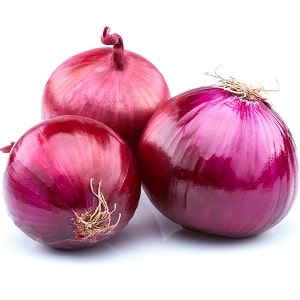 Crimson Ball (photo on the right) has a round shape with a dark lilac color and a semi-sharp taste. Ripens in 12-16 weeks, planted in seedlings (with a bitter taste) or in a greenhouse (sweeter). Does not like shade or moisture, can be stored for up to 4 months.
Crimson Ball (photo on the right) has a round shape with a dark lilac color and a semi-sharp taste. Ripens in 12-16 weeks, planted in seedlings (with a bitter taste) or in a greenhouse (sweeter). Does not like shade or moisture, can be stored for up to 4 months.- Bombay (Red Bombay) – mid-season variety with large dark red bulbs (150 g). It ripens in 130-140 days, has high yields, and is well stored.
- Brunswick – an early-ripening variety with bright purple husk and juicy pink onion pulp. The diameter of the flat-round bulbs is 6 cm. They are characterized by high yield and good shelf life.
- Greatful ripens in 110-115 days, is distinguished by uniformly sized fruits, and is stored for a long time.
- Danilovsky 301 – a selection variety of rich purple color with large bulbs (from 150 g). It has a sweet semi-sharp taste, is resistant to certain diseases, is well stored, and easily transported.
- Campillo F1 – a juicy hybrid with a delicate structure and a soft spicy-sweet taste. It has large, even purple bulbs and ripens in 4 months. Resistant to a number of diseases, stores well.
- Carmen cultivated in various climatic zones, ripens in 65-90 days. It has a rich violet-dark red hue and produces good feathery greens (up to 30 cm).
- Commissioner – giant purple onion with a sweet taste. Can be stored for 6 months.
- Red Brunswick has a purple husk color and a slightly pungent taste. Grows in 70-100 days from sets or seeds, resistant to diseases.
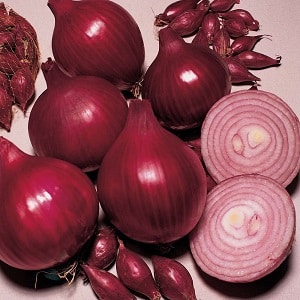 Orion grows well in northern regions, has a regular round shape and purple color. Head weight – 150-200 g.
Orion grows well in northern regions, has a regular round shape and purple color. Head weight – 150-200 g.- Red Baron (photo on the right) is a productive variety. It is distinguished by the dark red color of its scales and the small size of its heads (about 90-110 g). It has a sweet-semi-sharp, exquisite taste, ripens in 90-95 days, and is planted as sets or seeds. It produces good greens (feather), is frost-resistant, and can easily be transported.
- Red Semko F1 – early ripening hybrid. Ripens in 70-75 days. The taste is semi-sharp, the bulbs are large (from 100 to 200 g).
- Retro gives a harvest in 90 days. The bulbs are large, red in color, flattened, sweet in taste.
- Black Prince – a productive selection species, round in shape and purple in color, has a bitter-sweet taste. It ripens in 3-3.5 months, can easily be transported, and is stored for a long time.
- Yucont - semi-sharp variety. It grows only in the southern regions and the middle zone, and has good keeping quality.
- Yalta It has a purple color, a flattened shape and large heads (200 g), and has a sweet taste. The ripening period is 135-150 days. Capricious, grows only in the southern regions, requires specialized fertilizers. Can be stored for up to 4 months.
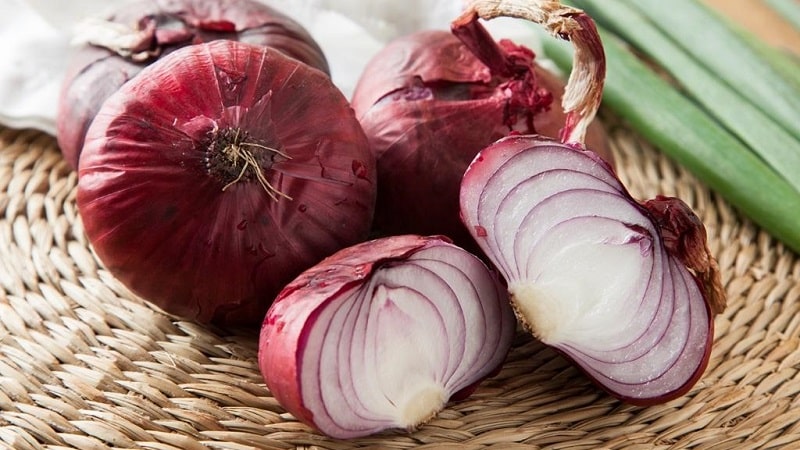
Growing regions and climate requirements
Hot and semi-sharp varieties are grown almost everywhere. In the northern regions with short and cool summers, early-ripening varieties ripen well, and the middle zone is more suitable for mid-ripening varieties, although early varieties also ripen.
However The southern sun gives the best yield and taste to blue onions and warm climate.
Advantages and disadvantages
Most varieties of lilac onions have a salad purpose, which determines their advantages and disadvantages.
Difference from other varieties
Purple onions don't have too many distinctive features, but they distinguish it favorably from its white and yellow relatives.
This bow has:
- Attractive appearance. The red-violet shades of the vegetable serve as a decoration for many dishes.
- Delicate taste – rich flavor palette, mild pungency, juiciness.
- Faint aroma. Red onions do not cause tears when cut.
- Beneficial features – increased content of vitamins and minerals.
Disadvantages of Red Onions:
- short shelf life - usually no more than 2-4 months;
- inconvenient way of landing;
- loss of beneficial properties during heat treatment;
- higher price compared to yellow bulbs.
Features of planting and growing
Salad red onion grown in one of three ways: seedlings, through onion sets or seeds (including through direct sowing). The best harvest is obtained in sunny, well-watered areas.
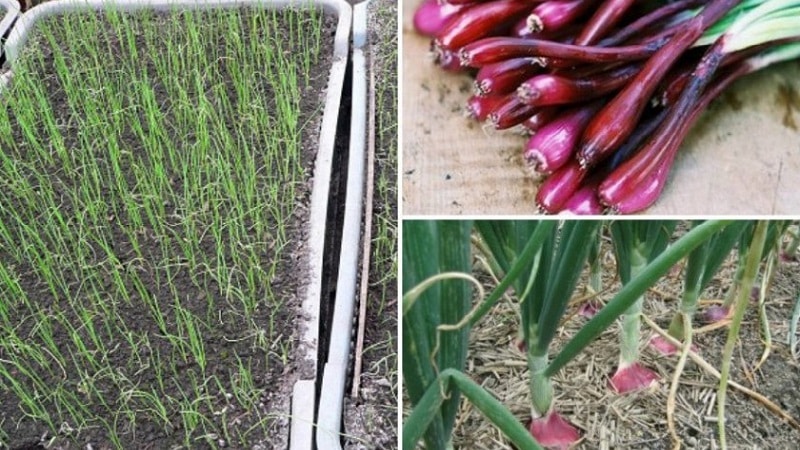
Variety selection
To determine the type of onion, they study:
- their features;
- demanding conditions;
- landing nuances;
- compliance of crop growth conditions with the climate of the region.
It is advisable to choose several different varietiesto avoid crop failure.
Soil requirements
To obtain a high-quality harvest of purple onions on the ground or in greenhouses, you need:
- in the fall, loosen the beds, add humus or compost;
- In the spring, dig the soil twice with a pitchfork and remove all the roots.
It is best to plant onions in the bed where they grew last season. cabbage, cucumbers, legumes, potatoes or beets. Carrots will be a good neighbor for onions - these two crops repel pests (onion and carrot flies) from each other.
Choose a well-lit place, rainwater should not stagnate between the rows.
Purple onions prefer sandy or loamy soil fine-lumpy structure with well-rotted compost.
The soil for seedlings is prepared from humus, turf soil and mullein (9:10:1) with a neutral reaction.
Preparing for landing
Seeds are planted in late February - early March using the chosen method, taking into account the following factors:
- Onions grown from seeds are resistant to diseases and pest attacks, but grow longer and produce later shoots.
- Onion sets are susceptible to disease, but they begin to grow much earlier and are easier to plant than seeds.
- Seedlings are selected for small planting areas or when large bulbs are needed.
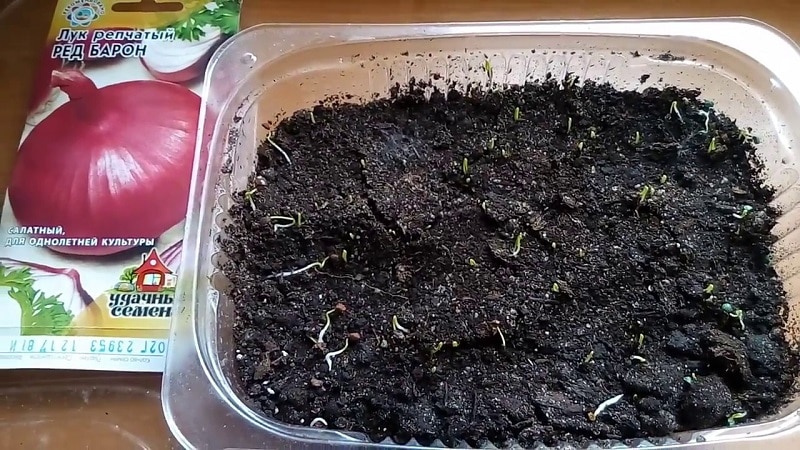
Semyan
For cultivation, fresh seeds are required, which before sowing:
- soak in clean water for 2-3 hours;
- transfer to a damp cloth for 3-4 days;
- disinfected for 8 hours in a strong solution of potassium permanganate (1 g per 1 liter of water) at a temperature of about 40°C.
Seeds are sown in prepared soil.
Sevka
Many gardeners grow red onions within two years.. In the first year, the seeds are germinated and brought to the state of onion sets, which are dried and stored until spring. The next year, the bulbs are planted in the ground in a permanent place and by the end of July they receive a harvest.
Seedlings
In early - mid-March, selected seeds are soaked in clean water (from 2 to 8 hours) with the addition of a growth stimulator (sodium humate), disinfected, planted in boxes with prepared soil and left at room temperature.
Dates, scheme and rules of planting
In warm regions, planting directly into the ground is possible., in regions with a harsher climate, seedlings are needed.
Landing in the ground
2 weeks before sowing, cover the bed with transparent film and provide maximum access to the sun's rays so that the earth warms up faster.
At the end of April - beginning of May, the seeds are treated or disinfected (20 minutes in a 1% solution of potassium permanganate or boric acid, followed by rinsing with clean water) to protect against infection and decay.
Seeds are planted along the bed at a distance of 15 cm from each other to a depth of 1-1.5 cm.
Low soil temperature (+7...+10°C) leads to later germination of sprouts.
Important! Planting time will be significantly reduced if you glue the seeds on narrow strips of paper at a distance of 3 cm from each other in advance at home. In this case, in the spring, paper with grains is laid out on the beds and sprinkled with soil on top.
After sowing, the beds are covered with a 1.5 cm layer of mulch made from humus or peat. and covered with light non-woven material for a month, which will retain heat and moisture and accelerate seed germination.
Planting seedlings
First, prepare the container for seedlings: in each container, drainage is made from small pebbles or disinfected expanded clay and peat mixed with garden soil is laid on top.
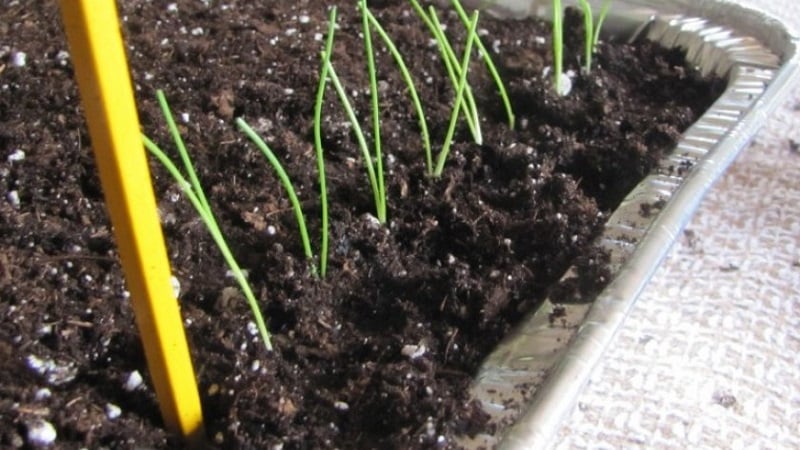
Selected seeds are soaked overnight in water with the addition of a growth stimulant., lightly dry, spread evenly on the prepared ground, sprinkle with a damp layer of soil 0.5 cm thick.
Before the first shoots (5-8 days), the containers are covered with glass. or placed in plastic bags to maintain moisture and stored at a temperature of about +22...+27°C.
After the sprouts appear, the cover is removed, spray the seedlings with warm water and place them in a cooler place (+10...+13°C). Water and fertilize periodically.
Seedlings are planted in the ground after 50-60 days in early May: in warm regions - directly into open ground, in others - into greenhouses or under shelters (film), which are removed at high temperatures.
Before transplanting, seedlings are watered generously, and to increase survival rate, roots and leaves are cut to a third of their length.
Nuances of care
When growing red onions during the season, do not cut off the feathers., as this prevents the development of large bulbs.
Watering mode
Throughout the growing season, onions are watered abundantly daily.. Insufficient moisture leads to feather growth and stopping the process of bulb formation, and excess moisture leads to fungal diseases.
By August, daily watering is replaced by watering once a week., which prevents soaking and rotting of the bulbs and extends their storage period.

Loosening the soil, weeding and fertilizing
In spring, the soil is carefully loosened with a rake.. Subsequently, shallow loosening of the row spacing is carried out until the plant stems close together.
Feed the plantings throughout the entire ripening period:
- First feeding (slurry diluted with water 1:10) is carried out 2-3 weeks after planting. Consumption – 1 bucket per 2 m².
- Second feeding (wood ash - 0.5 liters per row) is carried out during the formation of bulbs - at the end of June.
Once in May and twice in June, the onions are watered with an aqueous solution of mineral fertilizers. low concentration (20 g of the drug per bucket of water).
Disease and pest control
Properly prepared purple onions are pest-resistant and practically never gets sick.
Nevertheless, at the end of June - beginning of July, it is advisable to sprinkle the beds with shag for additional protection against onion flies.
Difficulties in growing
When growing purple onions face the following difficulties:
- It is difficult to get a sweet taste in countryside conditions. Onions planted in ordinary fertile soil acquire a bitter taste.
- It is necessary to carefully care for the seedlings.
- Purple onions have high demands on watering and heat when growing in open ground.
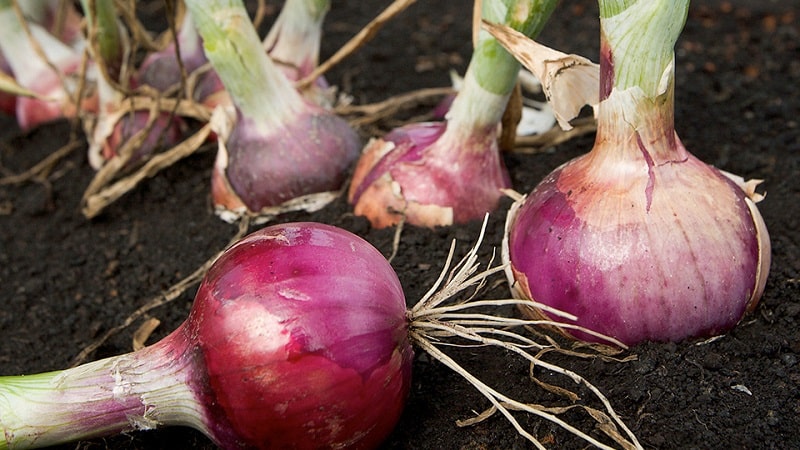
Harvest and storage
Benefits of Purple Onion – high yield, good keeping quality of spicy varieties, large heads.
How and when to collect
Leaves that have turned yellow and fallen to the ground are considered a sign of the maturity of the bulbs and their readiness for harvesting. (feathers), as well as a dried out top layer of husk that comes off easily and crunches when squeezed.
In the southern regions, onions are harvested on a warm and sunny day. at the end of July - beginning of August, in the northern regions - 2-3 weeks later.
Watering is stopped 10-14 days before harvest. and install rain protection.
Digging up bulbs using a pitchfork, manually cleared of soil and left to mature in the sun for 2 weeks.
In bad weather conditions, assembled onions are placed to dry in a ventilated area for 4 weeks.
Dried onions trimmed, leaving a tail 10-15 cm long and roots up to 5 cm.
Storage features and shelf life
The onion harvest is thoroughly driedto avoid rot.

A large harvest is sprinkled with wood shavings and stored in cardboard or wooden ventilated boxes (boxes) in a dry, cool place with good ventilation. Medium and small quantities are stored in nets (including nylon tights), wicker baskets or by hanging the bulbs on special hooks.
At home, onions are stored in a ventilated, dry room., on a glassed-in balcony or in the refrigerator.
Optimal storage conditions for onions:
- humidity – 60%;
- air temperature – +5…+18°С.
At least once a month, onions are sorted and spoiled specimens are removed from the common containerto avoid damage to the rest of the crop.
Advice from experienced gardeners
Tips for faster and better growing purple onion:
- It is convenient to plant seedlings in liter juice boxes;
- bulbs purchased on the market should be hard and strong, with a dry top, juicy and fleshy pulp.
Reviews of purple onions
Purple onions are a favorite of many gardeners.
Maria, Moscow: “I really love this bow. Not only is it delicious, but it also makes a great addition to salads. But I wouldn’t call it sweet, not at all. It still bites!”
Elena, Lugansk: “The Dutch selection Carmen is a savory variety, looks great when preserved, and can be stored for up to 8 months under the right conditions.”.
Anatoly, Naryan-Mar: “I grow Red Baron onions in the Far North. It doesn’t have a very pungent taste and has a satisfactory keeping quality.”.
Conclusion
The processes for growing red or yellow varieties are practically the same. The main thing is to choose the right variety and provide the necessary conditions depending on the region. In the south you can get a large harvest of almost any red onion, in cold areas - mainly hot and semi-sharp varieties.